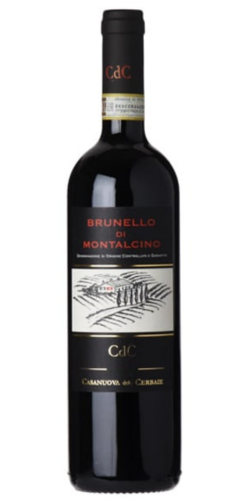
Our Rating

Toscana
Sangiovese
Casanuova delle Cerbaie began making wine in Tuscany in the 1980s. Ownership of this notable Brunello producer changed hands in 2008. The wine world was ecstatic that it was scooped up by an American wine lover who is invested in continuing its tradition of making collectible Italian wines.
Ray Welland, the lucky new owner of this prime Tuscan winery, is well-known in the wine community. This US financier and competitive master bridge player placed part of his 100,000-bottle wine collection up for auction in 2014, and the resulting sales crushed previous wine auction records. The bottles, most of which were Burgundies, netted Welland $6.6 million dollars when all was said and done.
Casanuova delle Cerbaie marks Welland’s second major vineyard purchase. In 2005, he was able to secure a slice of Gevrey-Chambertin in the legendary Côte de Nuits, one of the Côte d’Or’s most prestigious grape-growing regions. He currently leases the land to Domaine Dujac.
The vineyards of Casanuova delle Cerbaie are planted at 800 to 1000 feet above sea level. Vines planted at this height usually reside in soils that produce brooding, full-bodied flavors. In contrast, grapes grown towards the top of the vineyard hills result in wines with more prominent red fruit notes.
But that’s not what makes this property so special. You see, a good portion of the grapes used to produce Casanuova delle Cerbaie Brunellos come from Montalcino’s famous Montosoli Vineyard, which has been heralded as a “grand cru” in Tuscany. One of the unique features of the deal to buy the Casanuova delle Cerbaie winery was that the property included 1.5
hectares of Montosoli vineyards and 5.5 hectares of additional Montalcino vineyards.
Winemakers love working with grapes from the Montosoli hillsides because they produce Brunellos that have an unmistakable elegance to them. Like all great vineyard sites, part of what makes this venerable vineyard worthwhile is its soil composition. The soil, which is described as galestro soil, has clay-like qualities, but it hasn’t quite evolved into clay.
Galestro soil provides great drainage for vines, and certain parcels of the Montosoli Vineyard, in particular, are known for imparting a subtle salinity to the wines. An interesting fact about galestro soil: the best Chianti Classicos are also made from grapes grown in this soil.
In order for a wine to be labeled ‘Brunello di Montalcino’, these bottles must meet a few specific criteria. The DOCG designation, which was established in 1980, states that Brunello di Montalcino wines must:
If you start doing a deep dive into Brunello, there is one theme that is repeated over and over again: patience. There are wines you can drink a few years after bottling, and then there are Brunellos.
Most wine professionals will recommend holding onto your Brunello until it is at least ten years old. The Sangiovese grape is so incredibly thick-skinned that it needs time to mellow out in the bottle. If you open one of these wines earlier, say when they are released, you will be greeted with a wine that is overwhelmingly tannic – even if you try decanting.
Young Brunellos have a kind of in-your-face acidity and mouth-puckering tartness that can be difficult to get past palate-wise. While they are ripe with red fruit notes, wines at this stage of aging are very tightly wound and don’t showcase the quality of wine that the Sangiovese grape is capable of producing.
Casanuova delle Cerbaie wines are aged in new Slavonic oak, which comes from forests in a northeastern portion of Croatia called Slavonia. Wine barrels from Slavonia tend to have tight grain compositions, and due to their large size, a larger percentage of juice within the barrel comes in contact with the barrel wood. This benefits the wine by softening tannins and distributing more oak notes into the juice.
As for the 2012 Brunello di Montalcino from Casanuova delle Cerbaie, aromas of leather and smoke take flight from the glass. This heady mix is tapered by dark pitted fruits like plum and black cherry. Brunello wouldn’t be Brunello without that familiar leather and tobacco palate, and this wine has it in spades. Together with rich plum, cherry and strawberry, this Italian wine sings with complexity.
Generous tannins and a lower acidity combine for a long, gorgeous finish that we absolutely loved.
This Brunello from Casanuova delle Cerbaie would be wonderful with game meat like duck, wild boar, or any stewed meat, frankly. Braised pork shoulder or leg of lamb would also work well as a Brunello pairing.
Italy
Toscana
Sangiovese
14
Giuseppe Gorelli
90 Minutes
Now to 2032
Casanuova Delle Cerbaie


All things wine, and food you could ever need or want — straight to your email!